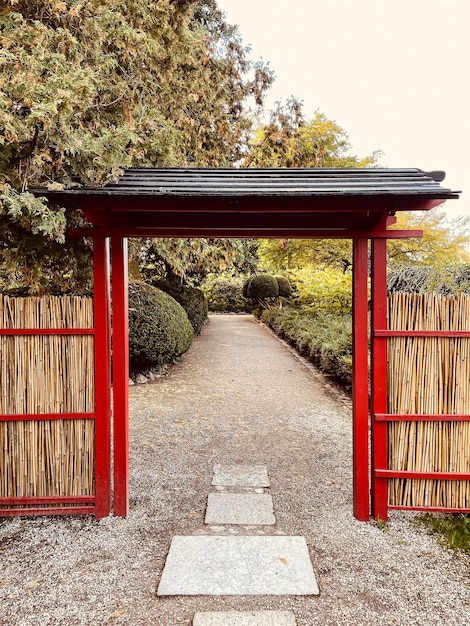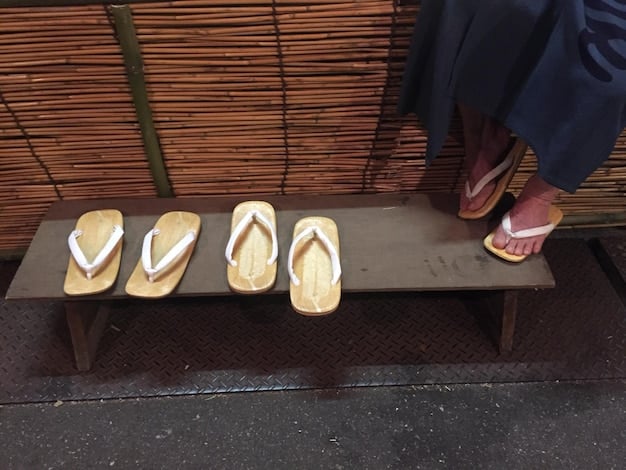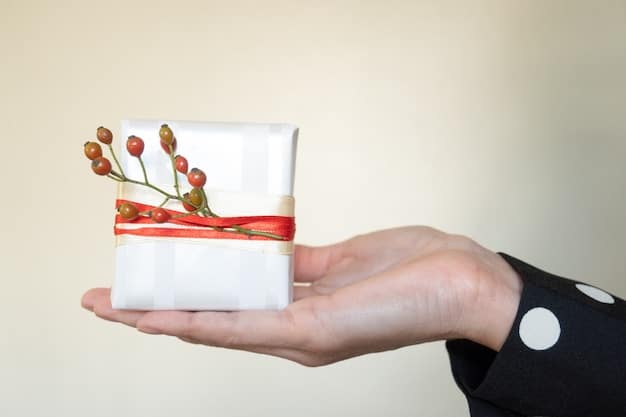Visiting a Japanese Home: A 2025 Guide for US Guests

Visiting a Japanese home requires awareness of specific customs to ensure respect and harmony; this 2025 guide outlines essential dos and don’ts for US guests to navigate cultural nuances effectively.
Navigating cultural differences can be tricky, especially when visiting someone’s home in a foreign country. This guide prepares US guests for a smooth and respectful visit to a Japanese home, ensuring a positive experience for everyone involved by highlighting the **dos and don’ts of visiting a Japanese home**.
Understanding Japanese Home Culture
Japanese home culture is deeply rooted in respect, cleanliness, and harmony. Understanding these core values is essential for any visitor, especially those from the US, where customs may differ significantly. By familiarizing yourself with the basic principles of Japanese hospitality, you can ensure a comfortable and respectful visit.
The Importance of Harmony (Wa)
Harmony, or “Wa,” is a central concept in Japanese culture. It emphasizes maintaining peaceful and cooperative relationships. In a home setting, this translates to being considerate of your host’s feelings, avoiding loud or disruptive behavior, and showing appreciation for their hospitality.
Cleanliness and Order
Japanese homes are typically very clean and organized. This reflects a cultural emphasis on purity and neatness. As a guest, it’s important to respect this by keeping your belongings tidy and avoiding any actions that could introduce dirt or disorder into the home.

Here are key aspects to keep in mind:
- Remove shoes at the entrance (genkan).
- Avoid eating or drinking outside designated areas.
- Refrain from speaking loudly or engaging in boisterous behavior.
Understanding the values of harmony and cleanliness will set the stage for a respectful and enjoyable visit to a Japanese home.
The Genkan: Entering the Home
The “genkan” is the entrance area of a Japanese home and is a crucial space where shoes are removed. This area serves as a transition between the outside world and the clean interior of the home. Knowing the proper etiquette for navigating the genkan is essential for making a good first impression.
Removing Your Shoes
The first and most important rule is to remove your shoes before stepping onto the raised floor of the house. This is a non-negotiable custom in Japanese homes. Place your shoes neatly on the side, often on a provided shoe rack or mat.
Slippers (Uwabaki)
Slippers, known as “uwabaki,” are usually provided for guests to wear inside the house. These are typically placed near the genkan for easy access. Put on the slippers after removing your shoes, ensuring not to step onto the raised floor without them.
Consider these points when entering:
- Avoid stepping directly onto the raised floor with your outdoor shoes.
- Place your shoes neatly to show respect.
- Use the provided slippers and avoid walking barefoot or in socks (unless specifically told otherwise).
Properly navigating the genkan shows respect for the cleanliness and order that are valued in Japanese homes, setting a positive tone for your visit.
Gift-Giving Etiquette (Omiyage)
Bringing a gift, known as “omiyage,” is a common practice when visiting someone’s home in Japan. This gesture expresses gratitude and appreciation for the host’s hospitality. However, there are specific etiquette rules to follow when selecting and presenting omiyage.

Choosing the Right Gift
When selecting omiyage, consider bringing a regional specialty from your area or a high-quality snack or treat. Avoid bringing anything overly expensive, as this can make your host feel obligated to reciprocate with a gift of equal value.
Presenting the Gift
When presenting the gift, do so with both hands and offer a humble statement, such as “Tsumaranai mono desu ga” (This is just a small gift). This shows humility and prevents your host from feeling pressured.
Here are things to keep in mind:
- Bring a small, thoughtful gift, preferably a regional specialty.
- Present the gift with both hands and a humble statement.
- Avoid giving overly expensive gifts or anything associated with bad luck (e.g., items in sets of four).
The act of giving omiyage is a sign of respect and gratitude in Japanese culture, making it an essential part of visiting a Japanese home.
Table Manners and Dining Customs
Dining in a Japanese home involves a set of specific table manners and customs that are important to observe. These customs are rooted in respect for the food, the host, and fellow diners. Understanding and following these etiquettes will ensure a pleasant and respectful dining experience.
Using Chopsticks (Hashi)
Chopsticks, or “hashi,” are the primary eating utensils in Japan. There are several rules to follow when using chopsticks, such as avoiding sticking them upright in a bowl of rice (as this resembles a funeral ritual) and using the provided chopstick rests when not in use.
Serving Yourself and Others
It’s customary to offer to serve drinks to others at the table, especially your host. Pouring your own drink is acceptable, but offering to serve others first shows consideration and respect.
Remember these key points:
- Avoid sticking chopsticks upright in rice or passing food directly from chopstick to chopstick.
- Say “Itadakimasu” before eating to express gratitude for the meal.
- Offer to serve drinks to others and say “Gochisosama deshita” after the meal to thank the host.
Observing Japanese table manners demonstrates respect for the culture and enhances the dining experience for everyone involved.
Bathroom Etiquette
Using the bathroom in a Japanese home also involves certain customs and considerations. Japanese bathrooms often have unique features that require specific knowledge to use properly. Familiarizing yourself with these etiquettes will help you avoid any potential faux pas.
Toilet Slippers (Toilet Slipper)
In many Japanese homes, there are separate slippers specifically for use in the bathroom, known as “toilet slipper.” These slippers are placed just outside the bathroom door and should be worn when entering and removed upon exiting.
Cleanliness and Water Conservation
Japanese bathrooms are typically very clean, and it’s important to maintain this cleanliness during your visit. Conserving water is also a consideration, as Japan faces periodic water shortages.
Keep these points in mind:
- Wear the provided toilet slippers when using the bathroom.
- Leave the bathroom as clean as you found it.
- Conserve water by not letting the water run unnecessarily.
Following these bathroom etiquettes shows consideration for the cleanliness and hygiene standards valued in Japanese homes.
Respecting Personal Space and Privacy
Respecting personal space and privacy is crucial in Japanese homes. Japanese culture places a high value on maintaining personal boundaries and avoiding intrusiveness. Being mindful of these boundaries will ensure a comfortable and respectful visit for both you and your host.
Knocking Before Entering
Always knock before entering a room, even if the door is open. This shows respect for the occupant’s privacy and gives them a chance to prepare for your presence.
Here are the guidelines to follow:
- Avoid touching or handling personal belongings without permission.
- Use honorifics when addressing your hosts.
Respecting personal space and privacy is essential for maintaining harmony and avoiding misunderstandings during your visit to a Japanese home.
| Key Point | Brief Description |
|---|---|
| 🚪 Genkan Entry | Remove shoes before stepping onto the raised floor; use provided slippers. |
| 🎁 Omiyage Giving | Bring a small, thoughtful gift (regional specialty) presented with both hands. |
| 🥢 Chopstick Use | Avoid sticking chopsticks upright in rice; use chopstick rests when not in use. |
| 🚻 Bathroom Slippers | Use toilet slippers when entering the bathroom, and remove them when exiting. |
Frequently Asked Questions
▼
Apologize immediately and explain it was an oversight. The host will likely understand, but it’s essential to acknowledge the mistake and show respect for their home.
▼
Yes, but ensure they understand the importance of being quiet and respectful. Bringing a small gift for the children of the host is also a thoughtful gesture.
▼
Try a small portion of everything and offer polite compliments about the meal. Avoid making negative comments, even if you dislike certain dishes. Gratitude is key.
▼
Learn a few basic Japanese phrases like “hello” (konnichiwa), “thank you” (arigato), and “excuse me” (sumimasen). Use gestures and a translation app if needed to communicate effectively.
▼
Declining an offer can be seen as rude. Accept a small portion, even if you’re not hungry, and express gratitude. If you truly can’t eat or drink more, politely explain your reasons.
Conclusion
Visiting a Japanese home can be a wonderful and enriching experience. By understanding and respecting the cultural nuances outlined in this guide, US guests can ensure a harmonious and enjoyable visit, fostering positive relationships and creating lasting memories. Remember that thoughtfulness and consideration go a long way in bridging cultural gaps and showing appreciation for Japanese hospitality.





